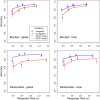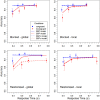Does attentional selectivity in global/local processing improve discretely or gradually?
- PMID: 24550875
- PMCID: PMC3909920
- DOI: 10.3389/fpsyg.2014.00061
Does attentional selectivity in global/local processing improve discretely or gradually?
Abstract
SOME RESULTS SUGGEST THAT ATTENTIONAL SELECTION IN GLOBAL/LOCAL PROCESSING OCCURS AT TWO STAGES: an early stage, where global and local information of a hierarchical stimulus is filtered or weighted according to the current goal, and a late stage, where the contents of the stimulus are bound to their respective level. Because it is assumed that binding improves attentional selectivity, accuracy should increase with response time. To see whether this prediction holds, a global/local experiment was conducted with hierarchical letters as stimuli, and where selection difficulty was varied by blocking vs. randomizing the target levels. The results show that accuracy indeed increased with response time, although to a lesser extent under randomized levels. Because an increasing accuracy is also compatible with a gradually improving selectivity, corresponding sequential sampling models were fit to the distributional data. The results show that a discretely improving attentional selectivity accounts better for the data. Moreover, the parameters of the corresponding model indicate that randomizing the target level impaired the efficiency of early selection as well as that of content-to-level binding.
Keywords: attentional selectivity; binding; early and late selection; global/local processing; sequential sampling.
Figures







References
-
- Brent R. P. (1973). Algorithms for Function Minimization without Derivatives. Englewood Cliffs, NJ: Prentice-Hall
LinkOut - more resources
Full Text Sources
Other Literature Sources

